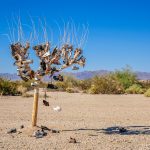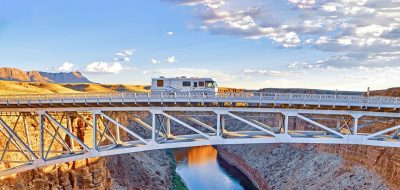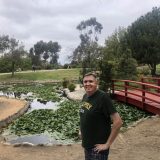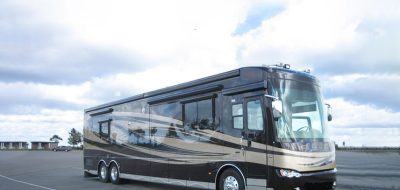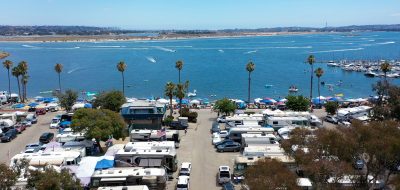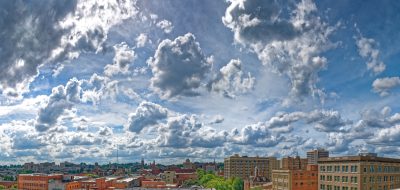The sun is out and the weather is great, just like any other day in Yuma, Arizona.

The Territorial Prison, also known as "Hell Hole" and "Devil's Island" opened in the Arizona desert on July 1, 1876 when the first 7 inmates entered the prison and they were locked into the new cells they built themselves. © Rex Vogel, all rights reserved
It should not surprise anyone that US News and World Report again named Yuma as the number one “sunniest place” in America to spend their golden years.
Yuma’s wonderfully temperate winter climate also makes this southeastern Arizona city a popular destination for snowbirds escaping their cold winter homes.
Arizona’s warmest winter city and the sunniest year-round spot in the U.S., Yuma has an annual average of 4,133 hours of sunshine. Yuma has a classic low desert climate with extremely low relative humidity and very high summer temperatures.
Located at the confluence of the Gila and Colorado rivers, Yuma began as a natural crossing of the then-wide and wild Colorado River.
In 1540, Hernando de Alarcon became the first non-native to explore the area, which was inhabited by the Yuma people, a combination of lower Colorado tribes including Quechans, Cocopahs, and Mohaves; and in the 1700s, Father Eusebio Kino passed through.

On the Colorado River in the southwest corner of Arizona, Yuma's been at the crossroads for centuries. © Rex Vogel, all rights reserved
But it wasn’t just Jesuits and Native Americans. In 1850, an estimated 60,000 people traveled through on their way to California and the Gold Rush. The town was first known as Colorado City, then Arizona City, before Fort Yuma was established in 1849. In 1853, the area joined the United States as part of the Gadsden Purchase from Mexico. The territorial government named the town Yuma in 1873. It is now the largest city in Arizona outside the metro areas of Phoenix and Tucson.
Yuma is the county seat and largest city of Yuma County, one of Arizona’s original eight counties. It is the 11th largest city in the state, with an estimated population (2010 Census) of 93,064, up 16.7 percent from the 2000 count of 77,515.
With the arrival of sun-seeking snowbirds, the population nearly doubles during the peak travel months of January, February, and March.
During the 1870s, Phoenix was little more than a slow place on the Salt River. The Arizona Territory was dominated by Tucson in the south, Prescott in the north, and Yuma in the west. Yuma had the political clout, so when the territorial Legislature voted to build a prison in backwater Phoenix, Yuma lawmakers scratched out the name Phoenix on the bill and inserted their town’s name. The deed was done.
The hulking Territorial Prison, which is still a major Yuma tourist attraction, opened in 1876 and quickly filled to capacity but continued to hold outlaws until a bigger big house was built in Florence in 1909.

Arizona has long been known for citrus and cotton–but the fertile lands surrounding Yuma at the Colorado River’s delta are lush and green all winter, serving as the nation’s salad bowl. © Rex Vogel, all rights reserved
In 1877, the railroad bridge over the Colorado was completed, from granite knob to granite knob. The transcontinental railroad still crosses at the spot.
In 1915, the first automobile bridge was completed and opened up the cross-country road system for the first time. The bridge, still called the Ocean-to-Ocean Bridge, parallels the railroad bridge right by the old prison.
The National Park Service declared the downtown Yuma area a National Heritage Area in 2000.
Farming, cattle, tourism, and two military bases are Yuma’s main industries.
The Yuma valley has some of the most fertile soils in the world, having received silt and mineral deposits from the Colorado and Gila River floods until the rivers were tamed by an intricate series of dams and canals.
Yuma is a major growing region for lettuce, dates, broccoli, cabbage, and agricultural seeds. It’s also the home of Arizona Western College.
Some of the major attractions around the Yuma area include the historical Territorial Prison, the Yuma Crossing Historic Park, the Kofa Mountain Range and Wildlife Refuge, and Martinez and Mittry Lakes.
Details
Yuma
Visitor Information Center: 201 N. 4th Avenue (Yuma Quartermaster Depot State Historic Park), Yuma, AZ 85364
Phone: (928) 783-0071 or (800) 293-0071
Website: visityuma.com
2012 Winter Events & Festivals
January 14-15: Gathering of the Gunfighters
January 28: Civil War Days
February 3: Yuma River Daze
March 10: 14th AnnualYuma Lettuce Days
March 17: 50th Annual MCAS Yuma Air Show & Open House
Worth Pondering…
Yuma, Arizona: Rated as having the best weather in the United States.
—Farmer’s Almanac
You May Also Like
- America’s Best Idea Still Getting Better
- Entegra Offers Mobileye Collision Avoidance System
- Peterson Introduces New Excel Winslow Fiver Floor Plan
- All-New Starcraft Fiver Now Available at Dealers
If you enjoy these articles and want to read more on RV travels and lifestyle, visit my website: Vogel Talks RVing.
